By Jay Pinsky
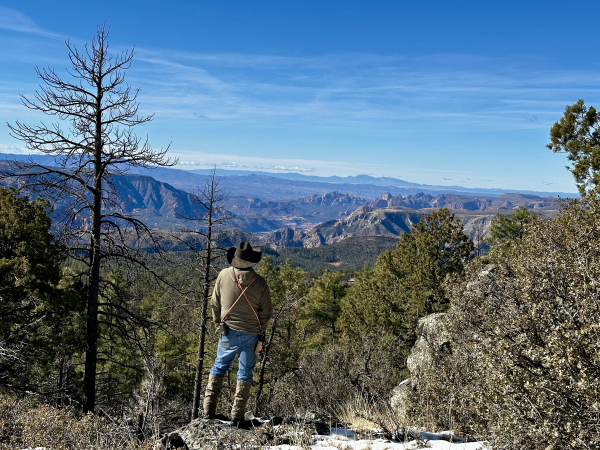
Way down south and even farther west of my home state of Virginia lives the Cat Lady of Arizona, Grace Moss.
True to form, Grace loves cats, big ones. If you've got the time and the lungs for it, there's nothing she'd like more than to take you and her pack of hound dogs up into the 8000 + foot mountains of Arizona to find a big cat - and kill it.
Grace Moss is a mountain lion hunting guide and a damn good one.
She is as fit and smart as any guide can be. Stone-cold and steady under pressure, she fears no forest beast and balances risk with just enough logic to give her clients all the adventure they can handle but still get them home in one piece. The local lion, bear, and elk population will tell you she's heartless, but they'd be wrong. Her heart, which she wears proudly on her sleeve, belongs to her hound dogs.
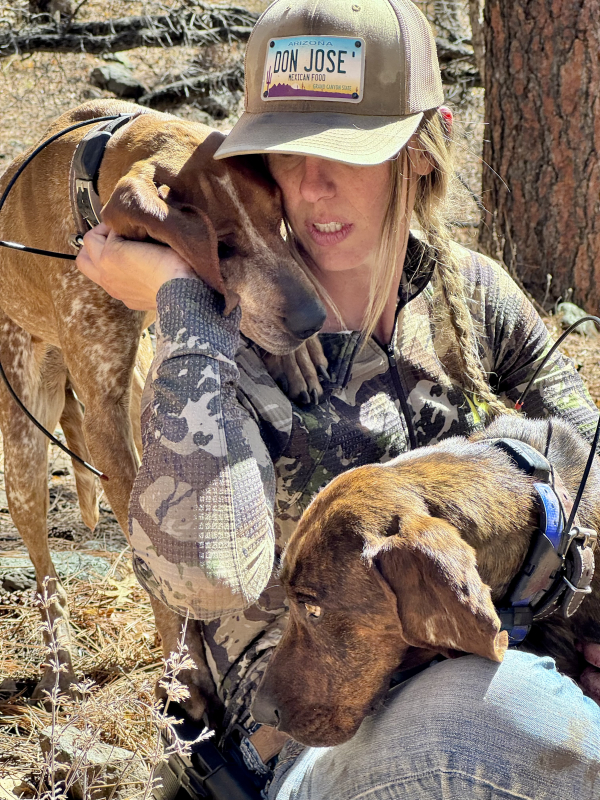
Five minutes into my first day of hunting with her, her sense of humor and matter-of-fact nature came through. We were climbing in elevation in her Chevrolet diesel truck to some of her favorite public hunting lands when I uttered, "Up we go; I guess that's why they're called mountain lions."
"They ought to be called canyon lions," she fired back. "That's where we'll find them." Grace's comment made perfect sense because the state known for some of the world's largest canyons has plenty of them, and while there's only one called the Grand Canyon, there are others that ought to be named the Pretty Good, the Wow, and the Holy $hit Canyons. We hunted them all.
On that same first day of hunting, the far less glamorous but overwhelmingly most important work of mountain lion hunting began – cutting tracks.
Finding a mountain lion track makes the old saying of finding a needle in a haystack laughable. Seriously. North America's largest cat is also its most elusive. One mature male, or "tom" mountain lion, can range from 50 to 500 square miles and exceed 1,000 square miles. Females, known as "queens," generally have smaller home ranges, averaging 20 to 100 square miles.
Meanwhile, while toms range farther, they counter-balance that elusiveness by leaving a much stronger scent than queens. In the end, the rarer mountain lion trophy is the queen because not only is her scent signature so much smaller than the prouder male lion, but her lighter weight means her tracks are even harder to find despite the much smaller home range. Hunters can only take queens without kittens.
The bottom line is that finding a mountain lion track in dry dirt is hard, but fresh snow sheds all of Mother Nature's secrets.
By mid-afternoon, and after countless false alarms, though, I shouted, "Grace, I got one!"
Sure enough, right next to a watering hole the soft mud betrayed a lonesome lion by revealing one perfectly formed paw print. Well-versed in its rarity, I celebrated with Grace, who was proud of her new mountain lion tracking apprentice, as if I had just found gold because I had.
She radioed Tim Rawlings, the senior guide and Grace's mentor, who was with my hunting partner and best Friend Bart Bauer, cutting tracks a bit farther down the road. They found their own set of tracks. The track we found was smaller and only showed one paw, so we headed toward their location just a few miles away. The commute, marred by steep inclines, declines, rocks, waterways, and deadfalls, made the pace of Friday afternoon Washington, D.C., rush hour traffic seem efficient. As such, despite Tim and Bart only being a few miles from us, we arrived too late to turn the hound dogs loose on the tracks. We left optimistic, though; we found two tracks on our first day. How hard could this be?

The next day Mother Nature favored the lions by sending a blizzard. White-out conditions, strong wind, and periodic rain forced the guides to "award" us an off day. That was the bad news. The good news is Day 3 began with a fresh layer of snow.
One thing mountain lion guides don't do is sleep. While Bart and I snoozed dreaming of hunting mountain lions, Tim drove hundreds of miles of Arizona public land looking for any sign. Well before sunrise the next day, Grace carried the two of us up to Tim, and we split up again. This time, I rode with Tim.
Tim has hunted almost anything and everything for over 40 years. Through it all, he's hunted mountain lions with hounds, and those 40 years of experience proved themselves within 30 minutes of meeting him for quite a few reasons. He foreshadowed the following:
"I think day one will be fair, I think we'll get snowed out day 2, but Saturday is our day," he said when we first met him.
He then asked me what gun I had brought, and when I showed him it was a Marlin Model 1894 44 Magnum Trapper with a rail and Vortex Defender red dot, he smiled. Then he pulled out his gun, a slightly larger, and heavier Marlin 45-70 – with a rail and red dot. He asked me what bullet I was shooting, and I showed him it was Hornady's 200-grain MonoFlex, which grouped the best in the Marlin. He paused, then said it was a good bullet, but it was too fast for our purposes. "Those go too fast. Next time, use a slower bullet with a soft lead core because we want the cat to fall dead from the tree, and this kind of bullet will pass right through it, and it may run off even with a perfect shot,” Tim said.

By the end of the week, not only would I recommend Tim and Grace as mountain lion guides, but I'd also second Tim as a fortune teller.
Less than an hour into our third day, Saturday for the record, Tim found a sustainable pair of tracks of a big Tom. He marked it, and then we rallied the two teams together and prepared the hound dogs for the hunt.
Hound dogs are the goofiest, friendliest, stone-cold killers you will ever meet. Tim's pack held all the veterans, while Grace, three years into guiding under Tim, had the youngsters, some with mountain lion memories and others, like me, with just dreams of them.
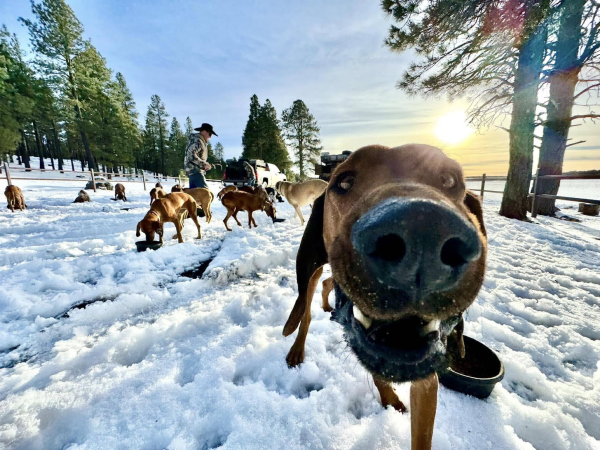
All of us were enthusiastic. None of us could keep up with the four-legged feline followers.
Grace took Bart and me up to the top of the mountain, where we waited out the pack of hounds who cold-scented the fresh set of tracks for quite a while. Tim and Grace still liked us, so they did their best not to drag us up, down, across, down, up, up some more, up a bit more, down, and across the mountain unnecessarily while the hounds figured out if and where the owner of those paw prints was. Not every pair of tracks produces a lion.
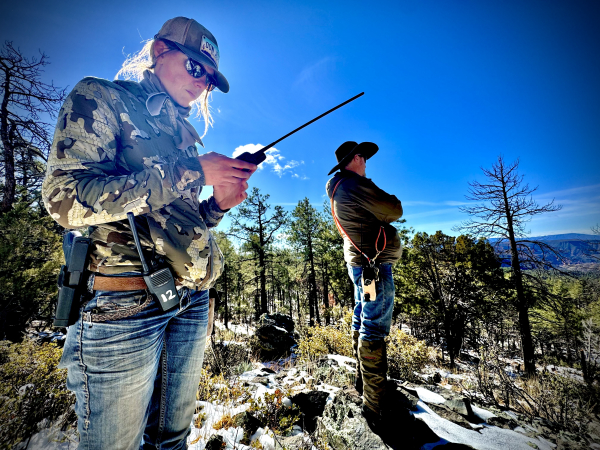
Hours passed as Grace, Bart, and I parallelled the dogs' track from up high. The short, light Marlin 1894 Trapper never reminded me it was on my back. The constant howls and barking kept reminding me that the hounds were still at work. Still, no one saw a lion, nor did we think the hounds had.
Regardless, we kept a steady pace to stay parallel with the hounds. Then, Grace took her feet out of first gear and floored it down the mountain, pausing just long enough to tell us the dogs had the cat treed. We were at about 7500 feet, and the dogs had the cat treed more than a mile and a half down the mountain around the 6000-foot mark. Nothing was gradual now. Honest to God, I have never flown down a mountain so quickly under my own power. For whatever reason, and with a hearty endorsement of Lacrosse's Ursa boots, I evaded the God of Clumsy as I bounded swiftly and surely down to Tim, who caught up to the dogs and the treed lion. Once I made it to Tim, I stopped. Then, momentum, which I outran coming down, caught up to me, and I fell flat on my face in front of the comically calm master guide.
"You ok," he said? "Yes," I panted. Tim had staged himself about 50 yards outside where the hounds had the lion treed. His pre-staging allowed everyone to catch up and, most importantly, gave him the time and the distance to talk me down from a level of excitement that made "Buck Fever" seem like the sniffles.
A mountain lion has a way of insisting you know your mortality even from 50 yards away. Once we got close, as in right under it, I felt much more than my own mortality, I felt the hand of God. Or at least I thought I did. Turns out it was Tim trying to calm me down. I kept reminding him, the guide with 40 years of experience, that there was a massive, mature, agitated mountain lion in front of us. Tim affirmed my observation every time and remained unphazed by it and me.
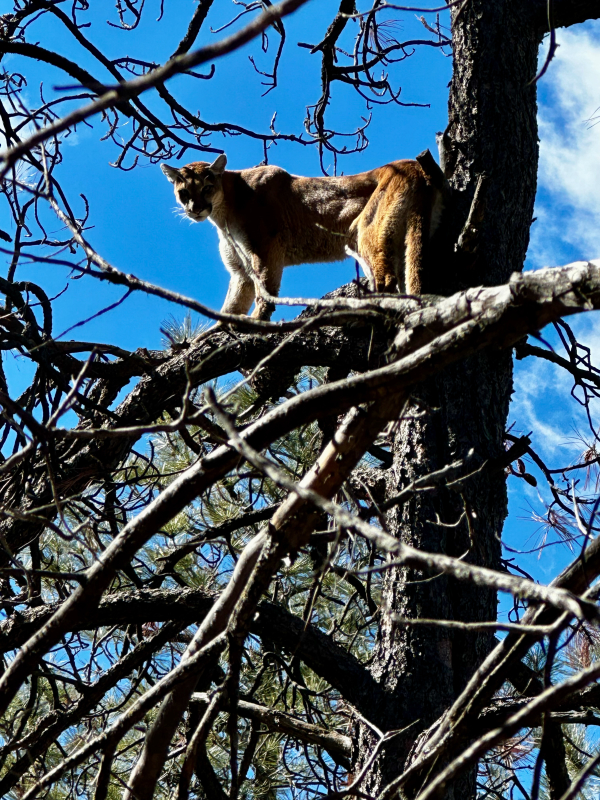
Despite my elevated enthusiasm for the situation, I managed to talk myself through the important stuff the rest of the way. I found a solid rest, eased my Marlin lever-action rifle onto the cat, and located the left front shoulder through the Vortex optic. The backlit cat washed my optic out, and I couldn't find my red dot. To my credit, I didn't panic. I reset the rifle, and my sight picture located the red dot, which was always there and then raised the gun again. I anchored the red dot squarely behind the left front shoulder and squeezed the trigger. The Marlin 1894 Trapper joined the hounds and barked, knocking the cat assertively out of the tree. True to cat lore, it landed on its feet despite being mortally struck with a 200-grain Hornady sleeping pill and bolted away from the tree. The hounds pursued it, and despite the visuals, we found the lifeless lion anchored by the pack of dogs less than 50 yards from where it fell.
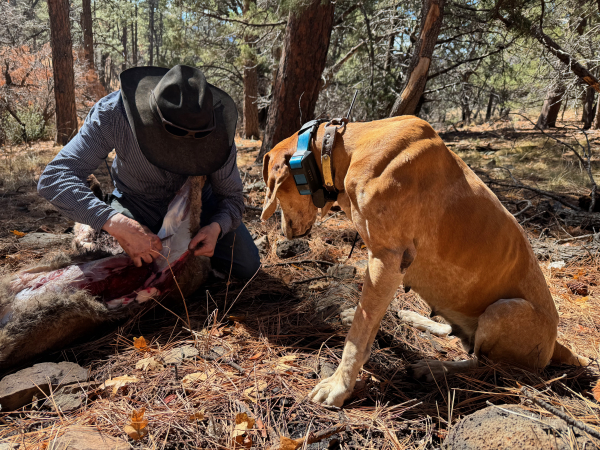
As I stood over the lion, heart pounding and breath still catching up to me, I took a moment to let it all sink in. The hunt—the miles of track, the relentless climb, the pounding in my chest as I steadied my shot—had all led to this moment which I was blessed to share with my best friend Bart, and two new friends in Tim and Grace.
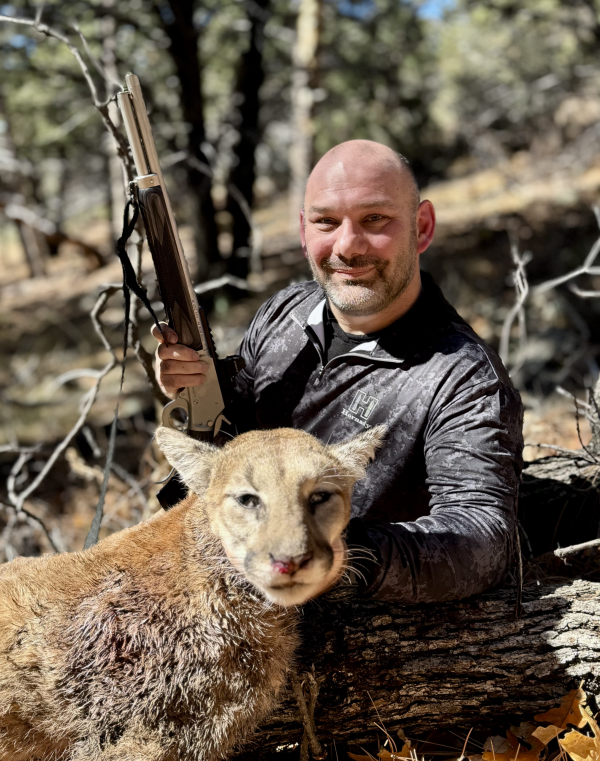
They all gave me nods of approval, the kind that needed no words. The hounds, their job done, circled proudly, their deep, satisfied howls echoing through the canyon. I ran my hand over the lion's coat, feeling the raw power and beauty of the animal, I had pursued. It wasn't just about the hunt; it was about the journey, the respect for the land, the knowledge passed down from seasoned guides, and the bond with the dogs that made it all possible.
As we packed up, I looked at Tim and asked, "Which way is the truck?"
"Up, Jay." He spoke. "Go up, and whenever you think you might be wrong, just keep going up because everything we want is up from here."
I shook my head and said to Grace, "Canyon lions sound about right."
And with that, we left the mountain, the echoes of the hunt fading behind us, but the memory forever etched in my mind.
If you’d like to hunt in Arizona, I can’t recommend Tim and Grace enough. Contact GT Hunts by email - gogetemgracie@gmail.com, or text or call 623-633-5029.